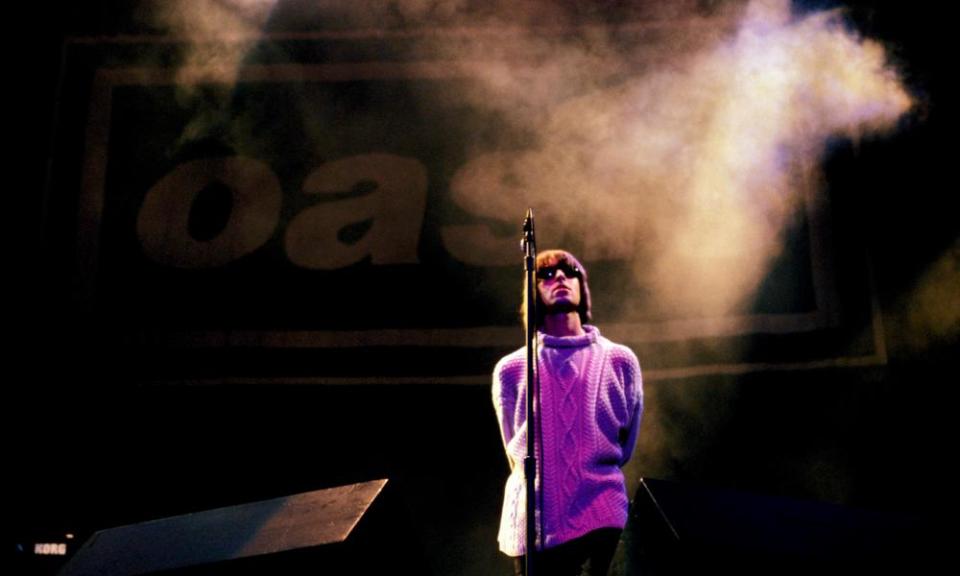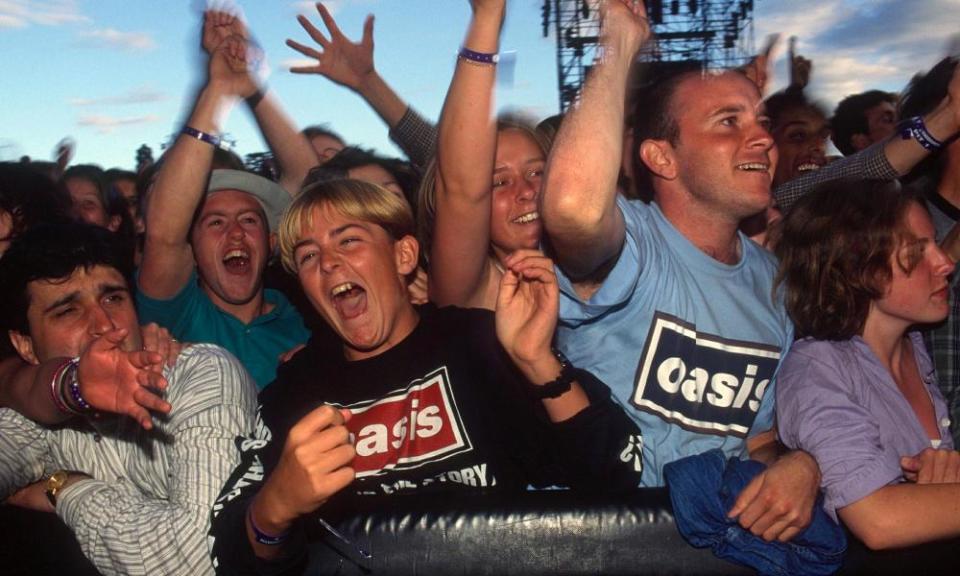Oasis Knebworth 1996 review – dreamy music doc looks back in languor

Pre-internet, end-of-history nostalgia reaches a psychedelic peak in this enjoyable documentary about Oasis’s pair of 1996 gigs at Knebworth House in Hertfordshire.
As the band and reminiscing punters assert here rather too often and too strenuously, with 125,000 people on each night, these were the biggest ever outdoor concerts in the UK (except 1970’s Isle of Wight festival was considerably bigger) and they could never happen again (except when Robbie Williams outdid Oasis with three nights at Knebworth in 2003). If the event’s uniqueness is slightly overstated, its significance is even more so: the tenor of the collected voiceovers suggests that this was the peak of British culture and all live music went downhill afterwards. It’s a lie every generation tells itself.
The truth, nevertheless, is that these were exceptionally good gigs. As Noel Gallagher explains, Oasis had almost entirely skipped the stage of playing theatre-sized venues – the mainstay of the successful British indie band – and instead went from pubs to arenas and then stadiums off the quickfire success of Definitely Maybe (1994) and (What’s The Story) Morning Glory? (1995). That sense of fans and band alike being caught in a sudden updraft is convincingly expressed in Jake Scott’s film, with pacy editing from Struan Clay.
Along with the voiceovers, they intersperse some convincingly mid-90s dramatisations of fans phoning for tickets, hopping in cars and trudging across fields to the gig, with the rest of the footage shot at the gigs themselves by a large team led by Dick Carruthers.

Carruthers’ work ranks alongside the recent Summer of Soul documentary: a priceless cache that documents a social moment as well as the music. He and his camera operators have a druggily humanist fascination in people and faces, scanning their euphoria, circling around their bodies – it very much feels like the next field along from rave culture. There are as many women as men, some filmed crushing on Liam like he was a Take That member. “They were us, we were them,” Noel says now: Oasis’s ascendency was so quick that the crowd were still caught in their slipstream.
It’s striking how young both crowd and band are, and the performances remind you of how attuned to youth Noel’s lyrics were at this point. There’s the existential giddiness – “We need each other / we believe in one another”, “Is it my imagination / or have I finally found something worth living for?”, “You and I are gonna live forever” – and the poignancy of how fleeting it is: “The years are falling by like the rain / it’s never gonna be the same.” It becomes clear that these lyrics, paired with the truly unrelenting brilliance of the melodies and a thunderously outward rock’n’roll that defied indie’s habit of navel-gazing, are why they are held so dear by their generation.
Liam’s voice, like a buzzsaw touching a tree trunk, was perhaps never so distinctive and strong, and even his now semi-estranged brother is full of praise on the voiceover: “Liam’s at his zenith – his voice, the way he looks.” It’s great to watch Liam close up, how he smokes like a darts player approaching the oche and rolls his top lip up his teeth in his cartoon sneer. His banter, absurd and ordinary at once, is endearing and there’s a heartstopping moment of pure fraternal love where he and Noel are filmed looking at each other in happy disbelief. It’s fun to nerd out on guest guitarist John Squire at close quarters as well, giving Champagne Supernova a highly technical, almost hair-metal solo.
The reminiscences from fans are less successful; they are a bit like being told about it in the sixth-form block on Monday morning – you’re happy for them but can’t help feeling left out. The assertion that mobile phones and social media came along and ruined mass gatherings such as this is tiresome and largely inaccurate, though it can’t be denied how deeply and purely involved in the gig the crowd is. And I loved the tale of a bloke who helped out a lost limo driver and was invited into the back to find Kate Moss and Anna Friel – the quintessential 90s teenage fantasy made real.
When Noel tells the audience at the outset of the second night that history is being made, it’s understandable – this was a major cultural event, and it must have been thrilling to feel part of something that felt bigger than itself. Arguably he, and subsequently this film, have freighted the event with greater meaning than it required: the joy of live music is in immediate, fleeting sensation, which doesn’t need to get caught on the hide of history. But that sensation is something Carruthers captured brilliantly in 1996.
• Oasis Knebworth 1996 is released on 23 September in cinemas.

 Yahoo Finance
Yahoo Finance 